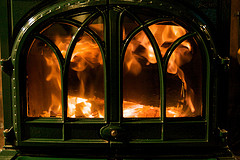
Rainy autumn days and blustery winds have many people switching their thermostats from “cool” to “heat.” However, since heating equipment accounts for 49 percent of the energy used in residential buildings in the United States, it’s important to remember that heating your home efficiently not only saves energy but can leave you with money to burn.
An easy first step for energy efficient heating is setting the thermostat as low as is comfortable during cool months. The American Society of Heating, Refrigeration and Air-conditioning Engineers recommends 68°F (20°C) when the house is occupied during the day and 60°F (15°C) at night. The Department of Energy estimates that five to 15 percent can be saved on energy bills simply by reducing the thermostat by 10-15 degrees for eight hours a day. Programmable thermostats can do this automatically and easily. They are inexpensive, reliable and easy to install.
Other tips from ASHRAE include:
- During the heating season, keep draperies and shades open during the day on your southern-facing walls to allow sunlight to enter. Keep them closed at night to reduce heat loss and the chill or “draft” you may feel from cold windows.
- Install caulking, weather stripping or use spray-in foams around exterior windows and doors or those between heated and unheated spaces (garages, basements, crawl spaces, attics). Read instructions for spray foams carefully. Expanding foams can exert enough pressure to cause doors and windows to jam or stick.
- Make sure supply and return vents, radiators and baseboard heating units are not obstructed by furniture, appliances or other objects and that air can flow freely to and from them. This will maximize the efficiency of your system and help distribute warm air throughout the room.
- Clean or change furnace filters in forced hot air systems once a month or more often as needed.
- Have your heating system maintained and serviced according to manufacturer’s instructions (usually once a year). Dirty filters, coils and fans reduce airflow throughout the system, which decreases performance and can damage your system.
- Check heating ducts for air leaks from joints and holes. Check with your local hardware store for the proper UL certified mastic or tape to use for the particular job.
- Insulate your hot water tank with an insulating jacket according to manufacturer recommendations. Some newer tanks already are insulated, so check product literature to determine if insulation is needed. Insulate the first six feet of the hot water pipes connected to the water heater.
- You can turn down the thermostat in rooms that meet one or more of the following criteria:
- are unoccupied
- can be closed off (closed doors) from the rest of the house
- have their own heating zone. However, do not do this if it adversely affects the rest of your system or could lead to freezing water pipes.
Other tips can be found at www.ashrae.org/consumer.
***Headquartered in Atlanta, ASHRAE, founded in 1894, is an international organization of 50,000 members. It is the world’s foremost technical society in the fields of heating, ventilation, air conditioning and refrigeration (HVAC&R). Through its meetings, research, standards writing, publishing and continuing education, the Society helps keep indoor environments comfortable and productive, deliver healthy food to consumers and preserve the outdoor environment.

